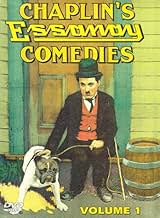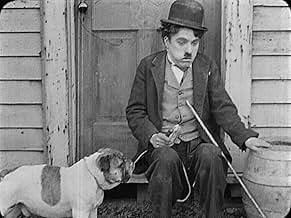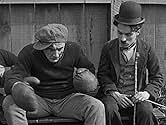The Champion
- 1915
- 31 मि
अपनी भाषा में प्लॉट जोड़ेंWalking along with his bulldog, Charlie finds a "good luck" horseshoe just as he passes a training camp advertising for a boxing partner "who can take a beating." After watching others lose,... सभी पढ़ेंWalking along with his bulldog, Charlie finds a "good luck" horseshoe just as he passes a training camp advertising for a boxing partner "who can take a beating." After watching others lose, Charlie puts the horseshoe in his glove and wins. The trainer prepares Charlie to fight t... सभी पढ़ेंWalking along with his bulldog, Charlie finds a "good luck" horseshoe just as he passes a training camp advertising for a boxing partner "who can take a beating." After watching others lose, Charlie puts the horseshoe in his glove and wins. The trainer prepares Charlie to fight the world champion. A gambler wants Charlie to throw the fight. He and the trainer's daught... सभी पढ़ें
- निर्देशक
- लेखक
- स्टार
- Bob Uppercut - Champion
- (बिना क्रेडिट के)
- Enthusiastic Fan
- (बिना क्रेडिट के)
- Sparring Partner
- (बिना क्रेडिट के)
- Second Sparring Partner
- (बिना क्रेडिट के)
- …
- First Sparring Partner
- (बिना क्रेडिट के)
- …
- Second Stretcher Bearer
- (बिना क्रेडिट के)
- Bit Role
- (बिना क्रेडिट के)
- Bit Role
- (बिना क्रेडिट के)
- Second Cop
- (बिना क्रेडिट के)
- Sparring Partner
- (बिना क्रेडिट के)
- Trainer's Daughter
- (बिना क्रेडिट के)
- Bit Role
- (बिना क्रेडिट के)
- Sparring Partner
- (बिना क्रेडिट के)
- Ringside Vendor
- (बिना क्रेडिट के)
- Spike Dugan
- (बिना क्रेडिट के)
- Crooked Gambler
- (बिना क्रेडिट के)
फ़ीचर्ड समीक्षाएं
During his apprenticeship at Keystone in 1914 Chaplin learned the rudiments of filmmaking from Mack Sennett, who liked his comedies low and fast. Thus, in his earliest movies Chaplin is concerned only with action and gags, and doesn't seem to care whether the viewer likes his character or not; sometimes he's an out-and-out rotter. But with this new series for the Essanay company Chaplin learned, first, to slow down a little and let things unfold as they may. More importantly, he learned to develop a sympathetic character viewers could care about.
The opening of The Champion shows Charlie sitting on a stoop with his only friend, an endearingly ugly bulldog named Spike, as they eat a meal. Charlie offers a sausage to Spike who, amusingly, chooses to eat only after the sausage has been properly seasoned. It's a charming scene and a leisurely one, and it sets an agreeable tempo. By the time the sequence is over, whether we've seen Charlie before or not, we like this poor guy and his ugly dog, and we're rooting for them. When Charlie decides to try his luck as a boxer he even manages to retain our sympathy when he employs less-than-ethical means to knock out his foe.
Later, we're troubled when Charlie appears to flirt with the idea of accepting a bribe from a crooked gambler, but ultimately the crook gets what he deserves and Charlie is more The Good Guy than ever. This sequence, in some respects, is the funniest in the entire film. Gambler Leo White is hilariously hammy, and Charlie peppers us with gags using every available prop: the paper money he grips in his mouth, the gun that points every which way, and even Leo White's villainous mustache, which Charlie reaches over and twirls one step ahead of the villain.
Everything builds towards the climactic battle. Chaplin fans taking the long view might regard this as a dry run for the big fight in City Lights, made in 1931, but for my money the boxing match in The Champion can hold its own as a great sequence in its own right. In addition to being well staged and beautifully timed, the scene features several notable participants silent film buffs will recognize. Charlie's tubby opponent in the ring is character actor Bud Jamison, at the beginning of a 30-year career supporting just about every prominent comedian of the era. In the stands meanwhile are two prominent players of the day, G. M. "Broncho Billy" Anderson and Ben Turpin. Anderson was among the very first Western stars, and also happened to be a co-founder of the Essanay company, producers of this film. Therefore Anderson was in effect Chaplin's boss, and his cameo (as a highly enthusiastic spectator) can be seen as something of a good-natured inside joke. Ben Turpin, on the other hand, had co-starred with Chaplin in his two previous comedies, but it's said that the two men didn't get along, and they went their separate ways after this point. Turpin is granted a very brief bit as a peanut vendor in the stands during the bout, clambering over spectators before he is bodily thrown out -- out of the stands, out of the film, and, in effect, out of Chaplin's orbit.
In any event, the fight makes for a funny and exciting finale, and it provides Spike the dog with one last moment of screen immortality. (Sadly, the dog was struck and killed by a car shortly after this movie was completed.) For Spike's co-star, The Champion was not only a vast improvement over his earlier work, but the first of many classic comedies.
This short is not great, but compared to the previous Essanay shorts, it is a major improvement. That's because this short is more like a mini-movie and is very plot-driven--something ALL great Chaplin shorts have in common. The final boxing sequence is funny but makes no sense--just turn off your brain and enjoy.
By the way,...I like the dog in the film. Dogs like this are cool.
I was so glad that this film was good. I was really disappointed with Chaplin's first two Essanay films His New Job and A Night Out. This is a real return to form. The idea was actually taken from a Fred Karno sketch that Chaplin performed before entering the movie industry. Perhaps one of the reasons for the film's success is that Chaplin knew what he was doing before he went in rather than partially making it up as he went along.
The film really shows its age with its inter-titles. There wasn't one occasion where I understood every word! But you have to remember that this film is 97 years old and language changes. Another thing that changes is people's attitudes and sensibilities towards kissing. It's hard to believe now but Hollywood once enforced a self censorship ruling that meant that no on screen kiss could last more than a couple of seconds. Although made in pre-code Hollywood, Chaplin got round this type of censorship by having his Tramp kiss Edna from behind a large beer bottle. It's a clever device that works around censorship.
The film is much slower and more measured than much of Chaplin's other work of the period and especially the work of Keystone. The opening scene in which Chaplin shares a hot dog with his equally starving dog is both very sweet and very slow and reminiscent of his later work. It's a complete opposite of his previous Keystone films.
The highlight of the film is undoubtedly the boxing. Watching Chaplin train in his trademark bowler hat is brilliant and the big fight itself is hilarious and extremely well choreographed. Chaplin and Jamison spend half the fight either falling over or in embraces, punching themselves in the face and the umpire obviously gets a few punches thrown his way too. Raging Bull this is not. You have to feel that the film is a precursor to Chaplin's massively successful City Lights which features his famous boxing scene. Another highlight is the fantastic makeup and over the top fake facial hair of the film's villain Leo White, a motif of Chaplin's early work. Without dialogue you are still always sure who the bad guy is with his deep dark eyes, pale face and enormous moustache.
This film is not up there with Chaplin's later work but shows great potential. It is a marked improvement on his earlier Essanay films and introduced a lot of action into his repertoire.
www.attheback.blogspot.com
A lot of times when I watch these early comedies from Chaplin, I get the feeling that he is often trying to create at least a mildly engaging story throughout which he can throw in a lot of kicking and punching scenes, but in this movie it's the kicking and punching the drives the plot, giving the film an unusually honest feel.
High-energy physical slap-stick is what Chaplin did best at that time, and smacking around a huge mountain of a man while he dances carelessly around as only he can is certainly a treat to watch. And the climactic battle between Charlie and the meaty Bob Uppercut (or Young Hippo, depending on which cannibalized version you may see) is well-acted and fun.
Mack Sennett like his comedies to be fast paced and high energy, without too much time wasted on things like characterization or even story. But in The Champion, Chaplin proves that we can have well-developed characters, an easily discernible story, and still have enough action and solid slap-stick to keep the shorter attention spanned audience members entertained. This is definitely one of the best short comedies that Chaplin had made up to that point.
क्या आपको पता है
- ट्रिवियाThe film was restored in 2014 through the Chaplin Essanay Project thanks to the financial support of the Niles Essanay Silent Film Museum.
- कनेक्शनEdited into Chase Me Charlie (1918)
टॉप पसंद
विवरण
- रिलीज़ की तारीख़
- कंट्री ऑफ़ ओरिजिन
- आधिकारिक साइटें
- भाषाएं
- इस रूप में भी जाना जाता है
- Charlie the Champion
- फ़िल्माने की जगहें
- उत्पादन कंपनी
- IMDbPro पर और कंपनी क्रेडिट देखें
- चलने की अवधि31 मिनट
- रंग
- ध्वनि मिश्रण
- पक्ष अनुपात
- 1.33 : 1
इस पेज में योगदान दें


































